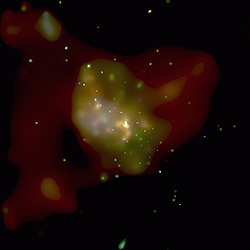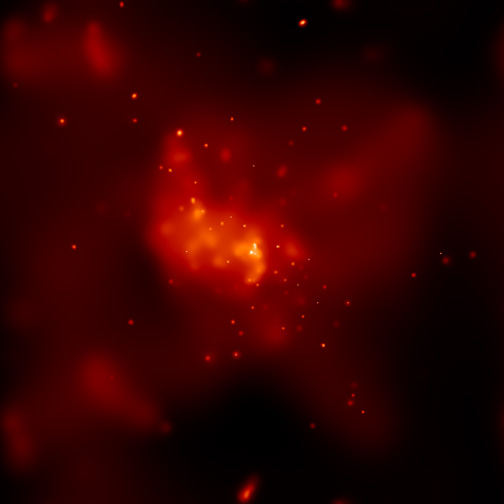September 5, 2001
RELEASE: 01-179
For the first time astronomers have detected material being consumed by the supermassive black hole in our own backyard. A violent, rapid X-ray flare, captured by NASA's Chandra X-ray Observatory, has been observed from the direction of the supermassive black hole that resides at the center of our Milky Way Galaxy.
A team of scientists, led by Fredrick K. Baganoff of the Massachusetts Institute of Technology (MIT) in Cambridge, detected a sudden X-ray flare while observing Sagittarius A*, a source of radio emission believed to be associated with the black hole at the center of our Galaxy.
"This is extremely exciting because it's the first time we have seen our own neighborhood supermassive black hole devour a chunk of material," Baganoff said. "It's as if the material there sent us a postcard before it fell in."
In a few minutes, the source brightened dramatically, eventually reaching a level 45 times brighter than before the flare. After about three hours, the X-ray intensity rapidly declined to the pre-flare level. "The rapid rise and fall of the X-rays from this outburst are compelling evidence that the X-ray emission is coming from matter falling into a supermassive black hole, confirming that it is powered by the same accretion process as quasars and other active galactic nuclei," said Baganoff.
Baganoff added that the data also provide the best look yet at the area just outside this event horizon, the surface of "no return" for matter or light falling into a black hole.
Studies of the central region of our Milky Way Galaxy in the infrared and radio wavebands indicate the presence of a large, dark object, presumably a supermassive black hole, having the mass of about 3 million suns. The faintness of Sagittarius A* at all wavelengths, especially in X-rays, has puzzled scientists who expected that the infalling matter should shine more brightly on its way in, and this has left some room for doubt.
The latest precise Chandra observations of the crowded galactic center region have dispelled that doubt. Given the extremely accurate position, it is highly unlikely that the flare is due to an unrelated contaminating source such as an X-ray binary system.
"The rapidity of the variations in X-ray intensity indicate that we are observing material that is as close to the black hole as the Earth is to the Sun," said Gordon Garmire of Pennsylvania State University, University Park, principal investigator of the Advanced CCD Imaging Spectrometer (ACIS), which was used in these observations.
"It's truly remarkable that we could identify and track this flare in such a crowded region of space," said Mark Bautz of MIT. "This discovery would not have been possible without the resolution and sensitivity of Chandra and the ACIS instrument."
Other members of the team Include: Niel Brandt, George Chartas, Eric Feigelson and Leisa Townsley, all from Penn State; Yoshitomo Maeda, Institute of Space and Astronautical Science, Japan; Mark Morris, UCLA; George Ricker, MIT; and Fabian Walker, California Institute of Technology, Pasadena.
The team first observed Sagittarius A* with ACIS on Sept. 21, 1999, and again on Oct. 26-27, 2000. The X-ray flare was detected in the second observation.
The ACIS instrument was developed for NASA by Penn State and MIT under the leadership of Gordon Garmire. NASA's Marshall Space Flight Center in Huntsville, Ala., manages the Chandra program, and TRW, Inc., Redondo Beach, Calif., is the prime contractor for the spacecraft. The Smithsonian's Chandra X-ray Center controls science and flight operations from Cambridge, Mass.
Images associated with this release are available on the World Wide Web at:
MEDIA CONTACTS
Dolores Beasley
Headquarters, Washington, DC
Phone: 202/358-1753
Steve Roy
Marshall Space Flight Center, Huntsville, AL
Phone: 256-544-6535
Megan Watzke
Chandra X-ray Observatory Center, CfA, Cambridge, MA
Phone: 617-496-7998




